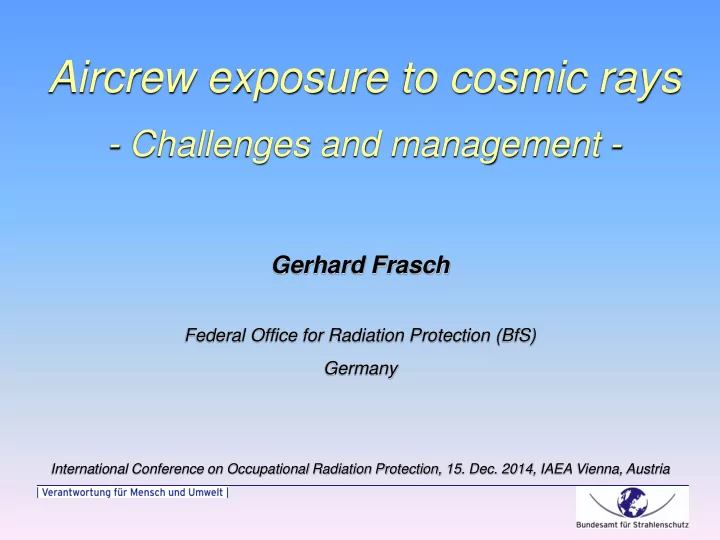

Aircrew exposure to cosmic rays - Challenges and management - Gerhard Frasch Federal Office for Radiation Protection (BfS) Germany International Conference on Occupational Radiation Protection, 15. Dec. 2014, IAEA Vienna, Austria
Content Cosmic radiation as existing exposure Physical, economical and social impacts Aviation and optimization Globalisation and future challenges
High altitude radiation Protons (> 1 GeV) Pions, Neutrons Myons Cruising altitudes : 10 - 15 km Elektrons Neutrinos Gamma
Solar activity in solar cycle 23 and 24
Geo-magnetic shielding of cosmic ray Ambient dose rate by latitude and longitude in 11 km altitude, Dec. 2002
Change of route doses 2004 – 2014 (solar cycles 23 / 24, FRA - JFK, FRA - JHB, Epcard Net 5.4.3) Δ = 28 µSv ( 56 % ) Δ = 3 µSv ( 12 % )
Radiation exposed workers Monitored workers and collective doses in Germany, 2012
Mean annual dose in work sectors Monitored persons with measurable doses, Germany 2004 - 2012 2009, solar minimum between 23. and 24. solar cycle
Monthly doses of aircraft crews Germany, Dec. 2003 – June 2013
Frequency distribution of doses German aircraft personnel, 2004 – 2009 - 2014 Flight attendants Pilots 2004 2009 2012
Typology of air crew members Female flight attendants by age and dose, Germany, 2004 Alter / Dosis [mSv] 0.1 - 0.5 0.6 - 1.0 1.1 - 1.5 1.6 - 2.0 2.1 - 2.5 2.6 - 3.0 3.1 - 3.5 > 3.5 Summe <= 25 275 175 331 248 360 322 180 286 2.177 26 - 30 227 308 547 452 804 722 398 244 3.702 31 - 35 261 417 576 424 640 606 259 85 3.268 36 - 40 261 474 875 641 711 509 227 28 3.726 41 - 45 85 211 570 453 404 324 97 8 2.152 > 45 47 111 255 263 299 306 122 9 1.412 Summe 1.156 1.696 3.154 2.481 3.218 2.789 1.283 660 16.437 Holm-Bonferroni test at multiple α– level: p < 0.05, 0.01, 0.001
RP problems in aviation Protection principle Application to aviation Practical consequences - more fuel consumption, Distance lower cruising altitude - higher cost, - more environmental burden. at fuselage - not feasible (weight), ineffective (energy), Shielding protective clothes - ineffective, not acceptable, cruising along lower latitudes - not applicable, - ineffective: longer routes more radia- tion exposure, - (see above). - more part time personnel, Time less block hours - economically not acceptable
Optimization by work planning • Allocation of personnel to route-mix • Multi-type employment of pilots: long-haul / short-haul mix within aircraft families Problems: Goal conflicts (flight attendants), costs
Optimization by flight planning Calculation programs for cost-optimized flight routes: Optimization criteria: Fuel consumption, flight time + route dose Problem: costs
Optimization en route RP policy of IFALPA* • Avoid flying above optimum flight level • Avoid last step climb • Avoid intermediate step climbs with following descent • Cruise at lower flight level with true air speed of originally planned higher flight level (at least for the later part of flights) • Act on ambient dose rate (on board dosemeter) *) International Federation of Air Line Pilots' Associations
Global airspace at 12:00 GMT
Going global - via North Pole
Future challenges • Development of new ultra-long-range aircraft ( > 15.000 km, altitude 43.000 ft.) • Longer non-stop flights (> 15 h, e.g. Singapore – New York) • Increase of long-haul route doses: by 30 - 50 % (estimation by VC Cockpit, Germany)
How to manage? • RP in aviation on international level • Co-operation with national and international stakeholders, in particular pilot organisations • Seek for synergy effects between radiation protection, flight safety and airline business needs.
Thank you! Quelle: http://www.lens-flare.de/flugzeug-zwischen-wolken-5655.htm
Recommend
More recommend